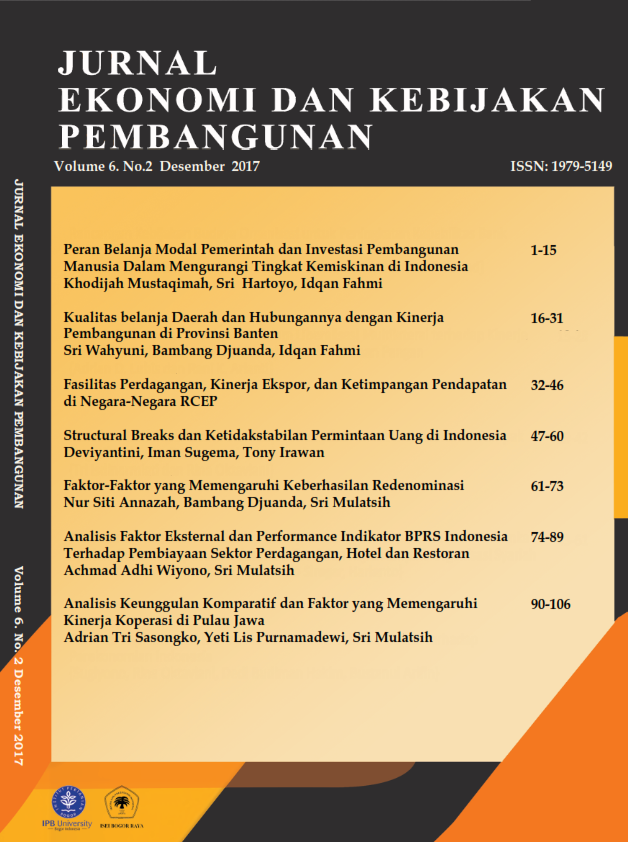FASILITASI PERDAGANGAN, KINERJA EKSPOR, DAN KETIMPANGAN PENDAPATAN DI NEGARA-NEGARA RCEP
Abstract
The growth of global economic integration has added pressure for countries to reduce trade cost to make trades more profitable and to encourage their further development. As tariffs have progressively fallen, efforts in trimming trade costs have focused increasingly on non tariff measures, which have a detrimental impact on the free flow of international trade, as such trade facilitation is considered an important complement to trade liberalization efforts aimed at fostering economic integration. Trade is expected to increase overall national income. The increase in national income can be used to improve welfare by increasing household income which translates into inequality alleviation. Regional Comprehensive Economic Partnership (RCEP) is a form of cooperation between 16 countries in the Association of Southeast Asian Nation and other major trading partner countries. This study uses a simultaneous panel method to identify the trade facilitation, export performance, and income inequality by using 12 countries in the RCEP region during 2011-2015 period. The results show that the advantages of trade facilitation in RCEP associated with export performance to decrease inequality in RCEP region and RCEP developing countries, but increase increase in RCEP developed countries.
Keywords: Export performance, Inequality, RCEP, Trade facilitation
References
ADB and UN (Asian Development Bank and United Nation). 2013. Designing And Implenting Trade Facilitation In Asia And The Pacific Update 2013. Philippines: Publication of Asian Development Bank and united Nation Economic and Social Commission for Asia and the Pacific.
Cabote N. 2014. Trade Facilitation And Poverty In Developing Countries. Case Study in International Political Economy The University of Tokyo.
Cuong NV. 2013. Poverty, Inequality and Trade Facilitation in Low and Middle Income Countries. Munich Personal RePEc Archieve Paper No. 50312, posted 1. October 2013
Dollar D, Kraay A. 2000. Growth Is Good for the Poor, Development Research Group, Washington, D.C., World Bank.
Itakura K. 2014. Impact of Liberalization And Improved Connectivity and Facilitation In ASEAN. Journal of Asian Economics. Xxx: xxx–xxx. http://dx.doi.org/10.1016/j.asieco. 2014.09.002.
Marquez G. Pagés-Serra, C. 1998. Trade and Employment: Evidence from Latin America and the Caribbean. WP-366, InterAmerican Development Bank, Washington, D.C.
Matsumura A. 2016. Regional Trade Integration by Environmental Goods. Journal of Economic Integration. Vol.31 No.1, March 2016, 1-40.
Otsuki T, Honda K. Wilson, JS. 2012. Trade facilitation in South Asia. South Asian Journal of Global Business Research 2 (2): 172-190. Doi 10.1108/SAJGBR-12-2011- 0052.
Pellan MI, Wong MH. 2015. Trade Facilitation in ASEAN+6 Economies. ASEAN and Regional Free Trade Agreements. Economic Research Institute for ASEAN and East Asia (ERIA).
Perez-Portugal A, Wilson JS. 2012. Export Performance and Trade Facilitation Reform: Hard and Soft Infrastructure. World Development. Vol. 40, No. 7, pp. 1295–1307. doi:10.1016/j.worlddev.2011.12.0 0.
Ravallion M. 2004. Pro-poor Growth: A Primer. World Bank Policy Research Working Paper No. WPS3242, The World Bank.
Revenga A. 1997. Employment and Wage Effects of Trade Liberalization: The Case of Mexican Manufacturing. Journal of Labor Economics, Vol. 15(3), S20-S43.
Shepherd B, Wilson JS. 2009. Trade facilitation in ASEAN member countries: Measuring progress and assessing priorities. Journal of Asian Economics. 20 (2009) 367– 383. doi:10.1016/j.asieco.2009.03.001.
Wilson JS. Mann, CL. Otsuki, T. 2005. Assessing the Potrential Benefit of Trade Facilitation: A Global Perspective. The World Economy World Development 40 (7):1295– 1307.doi:10.1016/j.worlddev.2011 .12
Authors

This work is licensed under a Creative Commons Attribution-NonCommercial-ShareAlike 4.0 International License.
The authors who publis article(s) in Jurnal Ekonomi and Kebijakan Pembangunan have to understand and agree that the copyright of article published is owned by Jurnal ekonomi and Kebijakan pembangunan including to reproduce, distribute and sell this journal to public.





